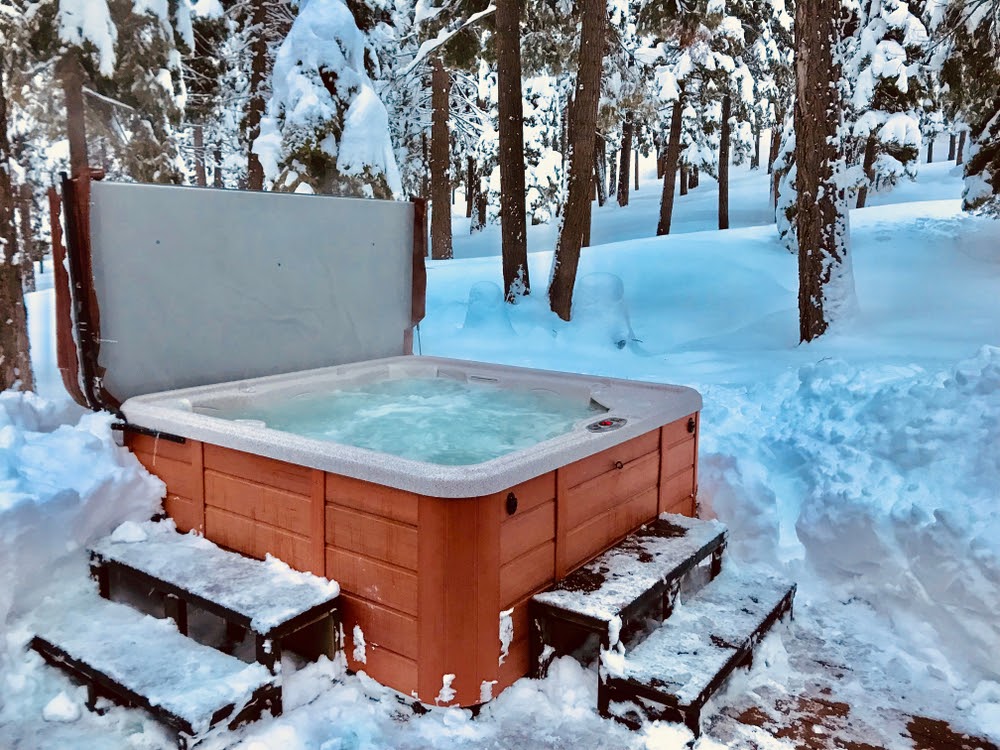Why to Choose an Energy-Efficient Hot Tub
During Covid, pools were so popular that contractors in charge of installing or building them were booked solid. For some homeowners, installing an in-ground pool also meant adding in a hot tub to provide a soothing, stress-relieving soak for adults working from home. Unfortunately, both pools and hot tubs may increase the energy costs of the home.
As summer draws near, homeowners are once again likely eyeing the addition of a pool and/or hot tub. However, installing an energy-efficient hot tub can save money and decrease the home’s energy use.

Heating a Hot Tub Can Be Expensive!
While pool costs are associated with water, maintenance and, of course, the power of the pump, hot tubs have something extra that may bump their cost: heat! The relaxation of a hot tub is all about the heat; hot tubs are heated either by electricity or gas.
There are numerous types of hot tubs or spas; they may be portable or built into the ground. Portable hot tubs are those you could move to different locations, and in-ground hot tubs are built into the ground. Some hot tubs also could be inflatable. Pool and Spa explains portable spas typically are heated via electricity.
The heating costs for these spas can vary for a number of reasons. Consumer Affairs explains that a hot tub can be more expensive to heat in colder climates, and an inexpensive hot tub could be more expensive to heat because it isn’t as well insulated (and heat escapes). In addition, indoor spas are cheaper to heat, and size and use also affect cost.
So how much does it cost to use that hot tub each month? Direct Energy reports that the cost of operation can vary wildly from merely $1 a month to around $50 a month. The electricity alone could cost about $0.90 per use in some cases. Again, though, the size of the spa and other factors contribute, too.
What Makes a Hot Tub Energy-Efficient?
Homeowners who are considering installing a hot tub might consider an energy-efficient hot tub to help cut down energy costs. What makes a hot tub energy-efficient? Master Spas explains that “full-foam insulation” is used in energy-efficient models.
Insulation in hot tubs will keep heat from escaping; this means less work for the heater (and less money for the homeowner). These models also have a tighter fitting cover, which, again, keeps heat insulated when the spa isn’t in use.
However, energy-efficient hot tubs are more expensive than standard models.
How Can Homeowners Decrease Energy Use for a Standard Hot Tub?
Homeowners may already own a hot tub and may have no intention—or budget—to upgrade to an energy-efficient model. If the hot tub is weighing down the energy bills, though, there are ways to cut costs and make a hot tub more energy efficient.
SF Gate offers a list of energy-saving tips when the hot tub is burning a hole in the energy bill. Here’s how to save:
- Buy a better fitting cover. When the hot tub isn’t in use, cover it! Make sure the cover is snug, so heat doesn’t escape.
- Add a thermal blanket for extra insulation. SF Gate recommends using a floating thermal blanket under the cover for even more insulation against escaping heat.
- Nudge down the thermostat a few degrees.
- Don’t forget to change the filters! Dirty filters can make the pump less efficient.
- Switch off the hot tub when on vacation or away from home. SF Gate emphasizes, however, that colder seasons require winterizing both the spa and pipes or leaving the heater on at a lower temp.
- Don’t waste electricity by leaving the lights or jets on when the spa isn’t in use.
- SF Gate also recommends creating a windshield with plants! This could block out air that might cause the heater to work overtime.

Other Ways to Maximize Energy Savings
Outdoor hot tubs are often installed next to inground pools. When homeowners are trying to save money on their hot tub energy costs, they also might look at ways to decrease the energy use of the pool, too.
In-ground pools also can have built-in lights, and homeowners might want to switch those off when the pool isn’t in use. In addition, homeowners could install an energy-efficient pump to help save even more money on pool energy costs. Pool covers could be beneficial to add to money savings for those who have heated pools; a pool cover could keep heat from escaping during a cool night. Installing an energy-efficient pool heater also could add to the monthly savings.
That outdoor oasis also could have more money-saving potential. To find all the outdoor energy savings, homeowners can download Benefyd and conduct an outdoor home energy audit. This may help them find all the hidden energy drains lurking outdoors.


